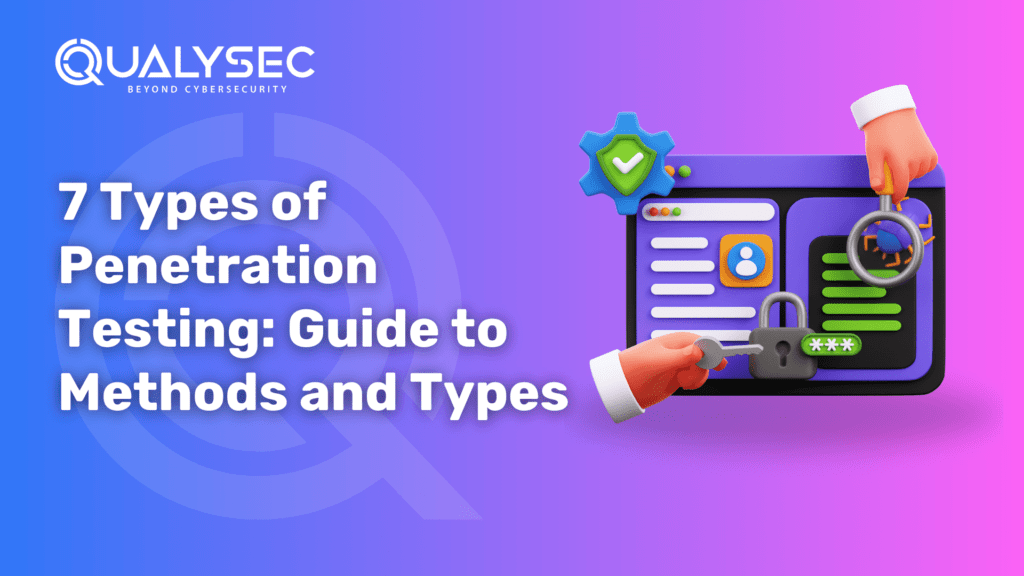7 Types of Penetration Testing: Guide to Methods and Types
According to a penetration testing report, 70% of firms do penetration testing to assist vulnerability management programs, 69% to assess security posture, and 67% to achieve compliance. A pentest is performed yearly or biannually by 32% of firms. If you are considering doing a penetration test on your firm, you may be interested in knowing more about the types of penetration testing available. With that knowledge, you’ll be better able to determine the scope of your project, recruit a suitable expert, and ultimately meet your security goals. What is Penetration Testing? A pen test is a type of ethical cyber security assessment that is used to identify, investigate, and fix vulnerabilities in a company’s network or applications. Pen testing employs the same tactics, methods, and procedures used by cyber criminals to mimic an actual assault on an organization, allowing them to determine whether their security policies are robust enough to survive various types of attacks. Pen testing, whether done externally or internally, may mimic a variety of attack routes. The demands of the organization being tested dictate the aims and outcomes of each pen test. The kind of assessment determines the degree of information provided to the penetration tester about the environment or systems to be tested. What is the Importance of Penetration Testing? Any cyber security plan must include penetration testing. Penetration testing aids in assessing an organization’s systems, applications, and networks’ security. Here are some of the top reasons why pen testing is important: Penetration testing assists firms in identifying vulnerabilities in their IT infrastructure and applications prior to malevolent hackers exploiting them. Businesses may increase their security posture by proactively identifying holes. It enables companies to identify and comprehend the possible risks they face, allowing them to properly prioritize and deploy resources to solve the most essential security concerns. This preventive strategy lowers the chance of security and data breaches, saving time and money in the long term. Security and data protection standards vary by industry and area. To verify compliance with these requirements, penetration testing is frequently required. Regular testing assists firms in avoiding penalties and legal ramifications while preserving customer and partner confidence. Talk to our Cybersecurity Expert to discuss your specific needs and how we can help your business. Schedule a Call Types of Penetration Testing You Should Know About Let’s look into some of the types of penetration testing. We have listed the top 7 types below: Web application penetration testing, often known as web app pen testing, is a security assessment method that aims to uncover vulnerabilities and flaws in web applications. It entails simulating cyberattacks in order to evaluate the application’s resistance to possible threats. The primary goal is to identify vulnerabilities and cybersecurity threats in websites and their components, such as databases, source code, and back-end networks. Identifying and addressing vulnerabilities aids in the prevention of data breaches, and financial losses, while also maintaining the security and integrity of online applications. Click to read more about Web application pen testing. Mobile Application Penetration testing is the process of examining a mobile application for security flaws. The purpose of penetration testing is to identify and report flaws in mobile security to developers. As the number of mobile devices and users has expanded, penetration testing has developed dramatically, for example, android and iOS penetration testing. Before releasing mobile-based applications for gaming, payment, shopping, and other purposes to the public, organizations should conduct mobile pentests. It should also be done after any big program changes. Organizations should consider undertaking mobile app penetration tests after any major upgrades, patches, or new feature additions, in addition to pre-launch testing. Cloud penetration testing is a security assessment technique that focuses on discovering flaws and vulnerabilities in cloud-based settings. It entails simulating cyberattacks in order to assess possible security vulnerabilities in an organization’s cloud infrastructure, services, and settings. The attack surface for cyber threats grows as more data and apps migrate to the cloud. Pen testing assists businesses in identifying and correcting vulnerabilities, misconfigurations, and access control concerns that hostile actors might exploit. Furthermore, frequent testing ensures that security stays dynamic and adaptable, allowing organizations to efficiently reduce risks and safeguard sensitive data. API pen testing is a security assessment method that focuses on detecting vulnerabilities and flaws in application programming interfaces (APIs). APIs serve as conduits for different software systems to communicate and share data. API pen testing entails simulating cyberattacks in order to evaluate the security of these interfaces and the data they manage. API pen testing assists businesses in identifying vulnerabilities, authorization problems, and data exposure hazards, allowing them to repair them before they are abused. Businesses may avoid data breaches, preserve user privacy, and maintain consumer confidence by undertaking extensive API pen testing, eventually protecting their brand and complying with legal obligations. Learn more about API Penetration Testing by clicking here! IoT device penetration testing is a security assessment procedure that focuses on discovering vulnerabilities and weaknesses in IoT devices and ecosystems. This pen testing entails simulating numerous attack scenarios in order to assess the security of these devices and the IoT networks to which they link. IoT pen testing is required because of the particular vulnerabilities associated with IoT devices, which frequently lack regular security upgrades and may have default or weak passwords. IoT pen testing assists in identifying and correcting security flaws, evaluating the resilience of IoT ecosystems, and eventually protecting against possible cyber-attacks. Blockchains are distributed ledger systems that serve as the foundation for cryptocurrencies and a broad range of other applications. Blockchain pen testing entails simulating cyberattacks in order to assess the security of blockchain networks, smart contracts, and other relevant components. Vulnerabilities, code faults, and implementation problems can pose major security threats, potentially resulting in financial losses and data integrity breaches. Blockchain pen testing aids in the discovery and resolution of these flaws, therefore protecting digital assets, maintaining the stability of smart contracts, and increasing confidence in blockchain systems. Click here to check out the top






